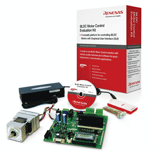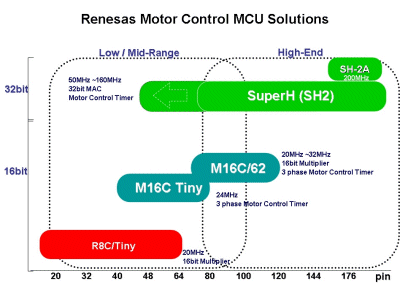Reference platforms and BLDC motor control apps
Decreasing engineering costs and development time
BY MICHAEL J. KAWA
Reference platforms are powerful yet simple-to-use development tools built around leading-edge microcontrollers whose feature sets and performance characteristics are optimized for use as motor controllers. The single-board design provides fully integrated hardware and preloaded software, allowing designers a quick and easy method of implementing and developing brushless dc (BLDC) motor control.
On-chip firmware libraries and motor control algorithms ensure that most of the application code is already developed so designers can simply choose the appropriate control algorithm and then concentrate on developing and evaluating their own target applications. Using a fully integrated communication interface, real-time system control and monitoring are achieved through a PC-based GUI. Users can easily change drive parameters and map system responses to optimize system performance, enhance reliability, and maximize power efficiency.
The primary function of the reference platform is essentially to demonstrate the full capabilities of the onboard MCU. It is designed to quickly familiarize users with the features of the MCU architecture and to facilitate evaluation of the MCU’s feature set and benefits.

Reference platforms such as Renesas Technology’s R8C/25-based BLDC Motor Control Reference Platform, gives developers quick and easy access to the latest BLDC motor control technology.
BLDC motor applications have increased significantly in recent years as energy efficiency, durability, and maintenance-free operation have become increasingly valued. Motor control designers are using the performance characteristics inherent to BLDC motors (see table ), giving them a distinct advantage over common ac induction and brushed dc motors used in similar applications.

The speed-torque curve of a BLDC motor is relatively flat, enabling them to operate in a wide speed range without conceding torque when the motor is loaded. This is particularly valuable for applications under 1 hp. Their output power relative to frame size for comparable motors is also high, offering a significant advantage when space and weight are important factors.
The brushless design eliminates brush friction and ionization sparks from the commutator, which allows BLDC motors to operate at a higher efficiency and have a longer life. This also reduces EMI noise and considerably diminishes audible noise allowing for quiet operation. Elimination of brush inspections also cuts down on maintenance making them ideal for semipermanent fixtures or applications with limited access.

Many MCU families, such as one from Renesas Technology,’s MCU families offer athe right balance between cost and performance to meet the full range of BLDC motor control applications.
Selecting an MCU
As motor control design falls increasingly on electronic control, semiconductor providers are developing diverse families of MCUs with wide-ranging performance, varied feature sets, and powerful development tools tailored to meet the ever expanding needs of BLDC motor control applications.
From a simple miniature speed control to rotate the disk in a computer hard drive to moving a large crane in a high-performance industrial application, the MCU must provide sufficient resources and processing power to run the selected motor control algorithm, interface to needed sensors, and drive the power switches that supply current to the motor windings.
The selection process begins by assessing the motor performance and control features necessary. Designers then select a motor control algorithm and a method of implementation to meet the performance profile. From this information, they can begin mapping the requirements necessary to select an appropriate MCU.
This involves allocating available CPU bandwidth to handle system monitoring tasks and additional processing performance required for handling the time critical operations of motor controls. CPU bandwidth must also be calculated under various operating conditions to ensure that enough headroom is available throughout the entire range of operation.
The design goal is to choose the best combination of control algorithm and MCU within the application performance requirements and budget limitations.
Motor control algorithms
The three primary types of control algorithms used for BLDC motor control are trapezoidal commutation, sinusoidal commutation, and vector (field-orientated) control. Each method of control can be implemented in different ways depending on software coding and hardware design; offering their own distinct advantages and disadvantages.
Trapezoidal commutation is popular because of the simplicity of its control circuits and software. It uses a six-step process using rotor position feedback from three Hall-effect sensors embedded in the motor. Trapezoidal commutation is very effective at controlling motor speed and power, but suffers from torque ripple during commutation especially at low speeds. It is ideal for low-end applications requiring simple closed-loop operation.
A sensorless technique is now often employed by measuring the back EMF of the motor to estimate the rotor position. This eliminates the need for Hall-effect sensors and their related hardware. Although it slightly increases the algorithm complexity, it provides similar system performance to the Hall-effect method while reducing costs, simplifying system design and reducing installation requirements.
Sinusoidal commutation uses carrier frequency modulation to drive the motor, simultaneously modulating the three-phase winding currents which vary smoothly and sinusoidally as the motor turns. This provides smooth and precise motor control, eliminating the torque ripple and commutation spikes associated with trapezoidal control. It can be operated by an open or closed loop using a speed sensor and is typically used in midrange performance applications requiring speed and torque control. The complicated commutation scheme does require additional processing power and control electronics to implement.
Vector control is reserved for high-end applications due to its somewhat more complex design and higher processing requirements. It commutates the motor by calculating voltage and frequency vectors based on feedback from phase currents. Vector control maintains high efficiency over a wide operating range and allows for precise dynamic control of speed and torque.
A sensorless technique can also be used, which eliminates the need for external feedback devices by employing a shunt to monitor motor current. Control is determined after comparing different current effects across the shunt to those of a mathematical model of the motor operating parameters saved in memory. This method reduces costs of the feedback devices, but significantly increases the processing requirements of the MCU.
Calculating CPU bandwidth
CPU bandwidth is a key microcontroller resource that must be determined to verify that the device can handle the processing requirements of a given application.
All control algorithms used for BLDC motor control provide three basic things for proper operation; a PWM voltage to control the speed, a mechanism to commutate the motor, and a method to estimate or monitor the rotor position. Each one of these processes consumes a certain level of CPU bandwidth. The designer must make sure that the cumulative bandwidth of these processes does not exceed the capacity of the MCU. This is determined during the development process by monitoring parameters such as commutation times, measuring and execution times of the feedback loops, and interrupt handling at different speeds and carrier frequencies (depending on the algorithm) to ensure that enough bandwidth is available through the entire operating range. ■
Visit http://motorcontrol.electronicproducts.com for more information on Reference Platforms Accelerate Design of BLDC Motor Control Applications. Renesas, as a semiconductor company with an outstanding portfolio of global market-leading products, has the technology and capabilities to deliver almost everything that is required in an age focusing on human needs, including security technologies, miniaturization and power-saving technologies, networking and interface technologies. Renesas aims to stay one step ahead and to be the true “intelligent chip solution provider,” serving the wide range of markets including motor controls. For more information on Renesas, visit http://america.renesas.com/motorcontrol.
Visit http://motorcontrol.electronicproducts.com to see full coverage of BLDC Motors Controls
Sponsored by Renesas • www.Renesas.com
Advertisement
Learn more about Renesas Electronics America





